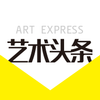分享到微信,
请点击右上角。
再选择[发送朋友]
或[分享到朋友圈]

2021-08-17 16:46
当我们在看一幅画儿的时候,我们在看什么?
今天的世界已经不同从前,敏感、碎片化,复杂多变都稀松平常,人们对于艺术作品的欣赏也裂变成不同场域的思想表达。观众生活在不同的文化环境之中,观看同一幅作品的视角不同带来的多元认知,成为今天艺术家创作的新思考。
叶宇轩的作品就像是一面反光镜或者《三体》中质子形成的世界映像,不同的观众可能解读出不同的意义,而艺术作品又将这一过程映像出来。
其中的赞碳系列,艺术家将活性碳粉加入水墨中,用车轮做“画笔”创作。从物理性状来说,活性碳具有很大的表面积和丰富的表面化学基团,即便很少的活性碳,依然具有非常大的表面积,它是一种吸附能力非常强的材料。这个系列中有几幅很像是数学中无穷大的符号,与活性碳无限大的表面积的物理性状不谋而合,也许在艺术家眼里,物理和数学并无差别,和天地万物一样,也和人类或者其他生灵一样。正如艺术家自己所说:“祈愿众生善待自然与万物同体共生。” 所以在赞碳系列--永生之一中,艺术家在无限大的象限的一边画上了一些观看方向、表情、情态各不相同的眼睛,另一边则像是黑洞般的墨迹氤氲,用梦境一般的意象呈现出永恒的心灵世界。
石涛曾说:“笔与墨会,是为氤氲。氤氲不分,是为混沌.”也许艺术家正是以这样的水墨艺术语言表现天地之混沌。美国学者詹姆斯 . 格雷克(James Gleick)说“在一个有熵支配的宇宙中,一切都无情的趋向更大的无序。
家把一些奇幻的、异质的想象元素带到绘画中,进行梦境的”重构“--这很像是超现实主义思维。超现实思维在弗洛伊德”潜意识“论和博格森的”直觉主义“带领下,关注人们的心理表白和想象梦幻。艺术家突破了传统水墨画的表现范畴,在作品中呈现出主观化的精神建构。
在这个系列的另外几幅作品中,艺术家将其中一个无穷大的象限当成孕育生命的子宫,另个则是虚空。对于修行之人,可能从中悟出:一切的生灵终将投入虚空之中,或者反之,一切的虚空也将孕育成为千姿百态的生灵。如《楞严经》中所说:“清净本然,何忽生山河大地?”,这句话的意思是:山河大地次第迁流,终而复始,都是妄相,不要为其所迁,保持清净本然之性。黑白的水渍和墨色形成周而复始的循环往复,不正是寓意着山河大地的往复本然?无穷大的另一个意义是不是往复本然呢?
在艺术家赞碳系列的另外一些作品中,车轮的痕迹深浅不一,似乎包含一种节奏,或急骤或徐缓,演绎出音律感,似乎那些由废弃的轮胎造成的痕迹会跳跃和呐喊。车轮是现代人最常使用的交通工具的一部分,承载着现代都市人的喜怒哀乐。理性的物理、数学,世俗的车轮,意识流的水墨混合成一种戏剧性的视觉张力。
[ 石涛《苦瓜和尚画语录》,卢辅圣.《中国书画全书》(第八册) M,上海:上海书画出版社, 1994,第 584 页 ]。美国学者詹姆斯 . 格雷克(James Gleick)说“在一个有熵支配的宇宙中,一切都无情的趋向更大的无序。”[ 《混沌--开创新科学》【美】詹姆斯 . 格雷克着,张淑誉译,郝柏林校,高等教育出版社, 2014 年,第 7 页 ]
显然艺术家不仅仅只是做水墨的游戏,他关注更加深刻的问题:关于地球上的生灵与所处环境的和谐关系。人类作为地球生命之一,却背离了大自然的生命轨迹。在“空污系列”作品中,艺术家关注人类生活环境的恶化,用技术手段采集雾霾灰尘运用到水墨当中,表达空气、水、土壤的污染对地球各类生物的威胁。艺术家说:“以笔墨造境传情,唤起人类和万物对当下环境遭破坏的恐惧担忧之情,真正的由内心激起保护环境之意识。”作品在观众中承担“唤起”的意图,这需要观众自主的诠释。现实世界中,不同的诠释社群对艺术品有着不同的期待视野。因此他们经常从不同角度诠释同样的文化客体。另外,人们对艺术客体的审视方式也有所不同。对于艺术,人们可以采用不同的注意层次(levels of attention) [《艺术社会学》【英】维多利亚 .D. 亚历山大着,章浩 沈杨译,江苏美术出版社(2013), 240 页 ]
而叶宇轩的“空污系列”作品关注到不同文化客体的注意力。作品中呈现的精灵是呐喊着、扭曲着、诉说着或者恐惧着的。水,是这个系列作品中很突出的一个元素,无论是艺术语言,还是思想表达,都呈现出关于水的探索。但创作手法却是后现代的--用水墨的材料,融合不同的文化元素,形成一种自洽的迥异色彩。这也许是不同观众都可以理解其作品意义的原因吧!《艺术社会学》【英】维多利亚 .D. 亚历山大着,章浩 沈杨译,江苏美术出版社(2013), 24 页
我和叶宇轩先生相识超过十五年,知道他内心中的灵性修为,其人也是一名环保志士。叶宇轩的枯山水系列作品呈现一种自然的混沌,“混沌”恰是自然界中最原本的现象。传统水墨画中的枯山瘦水在叶宇轩的作品中仅仅出现一些影子,混沌才是真正的色彩,无序且无尽,这是一种残酷的提示,观众不难感受到艺术家对于现实山水的担忧。在 “吾水系列”作品中,艺术家回归到形象。我们似乎可以看到被塑料瓶困住的飞鸟、海龟,生活在污染海域的虫鱼,或者因为污染而产生的怪异物种。这些看似具象的“物”的表现,事实上引导观众“悟”,艺术家内心世界的外延通过观众的观看而自足圆满。作品的一部分是叶宇轩作为创作者完成,而另一部分则很可能由观众完成,他们阐发出不同的作品释义。面对叶宇轩的作品,我们真的看到了什么吗?也许是的面对我们周遭的环境,我们应该做点什么了,也许这也是艺术家所期望的。
Being Within and Beyond Essence
When we are looking at a painting, what do we see?
Today‘s world is not like the old world, it is sensitive, fragmented, and complex variability is all everyday norms. People’s appreciation of artwork has also fragmented into expression of thoughts in different fields. The audience lives in different cultural environments, and their different perspective when looking at the same work also brings diverse awareness, and this has become new points of contemplation for today‘s artist when creating works. Yeh’s work is just like a reflective mirror or the image of the world formed by protons as described in the sci-fiction series the Three body Problem. Different viewer‘s interpretation will generate different meanings, and the artwork will reflect this entire process.
Of which, Praise of Carbon Series, where the artists added activated charcoal dust in the water ink, and used wheels as paintbrushes to “draw”. For a physics point of view, activated charcoal has a very large surface area and abundant surface chemical groups, and even low concentration of activated charcoal has a very large surface area, with very strong adhesive properties. In this series, there are quite a few works that look like the infinity symbol in mathematics, which coincides with the activated charcoal’s physical property and infinitely large surface area. Perhaps in artist‘s point of view, there is no difference between physics and mathematics, which is similar to that everything in creations are the same, and that all living things are equal to human. Just as the artist said himself, “I pray that all mankind is kind enough to nature to live together with all other creations.” So in the Praise of Carbon Series -Eternality I, the artist drew a lot of eyes looking in different direction with different expressions and moods inside one of the loops of the infinite symbol, while the other loop is blackhole-like mix of Ying and Yang, presenting the eternal spiritual world through dream-like imageries.
Shi Tao, a Qing Dynasty artist, once said, “The interraction of the paintbrush and ink is Ying and Yang coming together. Chaos is when Ying and Yang is mixed together.” Perhaps the artist is using this kind of artistic ink language to shows the chaos in heaven and earth. The American scholar, James Gleick, said, “In a universe dictated by entropy, everything is ruthlessly heading towards greater disorder.”
Painter brings some fantastical, exotic, imaginative elements into paintings, to “reconstruct” the dream realm - this is very much like surrealism. Under the guidance of Freud’s subconscious theory and Bergsen‘s intuitionism, surrealism is focused on the psychological confession, imaginations and fantasies or man. The artist broke the traditional scope of expression for water ink paintings, and presents subjective, spiritual construction in the works.
In other works in this series, the artist depicts one loop of the infinity symbol as the life-nurturing womb, while other loop is the void. For spiritual practitioners, they may come to realize that all living beings shall enter the void; conversely, all void may nurture the myriad of living beings. Just as stated in ?ūra?gama Sūtra, “All is empty and pure, so how did the mountains, river and earth suddenly arise?” The meaning of the phrase is that, “the mountains, rivers and the land are secondary changes that do not always exist. When they end, they would begin anew. They are all illusions, so do not be moved by them and hold fast to your empty and pure nature.” The black-and-white water stains and ink create a continuously repeating cycle; is this not an allegory for the mountains, rivers and land returning to their true nature? Is infinity not another symbol for returning to one’s true nature?
In the artist‘s other works in the Praise of Carbon Series, the trails left by the wheel were not consistent, sometime light, sometimes heavy, and it seemed to involve some sort of beat, sometimes quick and sometimes slow, giving an interpretation to the sense of rhythm, as if the marks left by those abandoned tires could jump and holler. The wheel is part of transportation that modern man most often uses. In part, it carries all the emotions of the modern city-dweller. The sensibility of physics, mathematics, the secularity of the wheel, the stream of consciousness of the water ink mixed together to create a dramatic visual tension. (Monograph on Painting Theory by Shi Tao; Lu Fu-Sheng, pp. 584, vol 8 M of The Complete Chinese Paintings; Shanghai: Shanghai calligraphy and painting publishing house (1994))
Perhaps the artist is using this sort of water ink artistic language to present the chaos of heaven and earth. The U.S. scholar James Gleick said, “In a entropy-dominated universe, all are ruthlessly heading towards greater disorder (pp 7, Chaos: Making a New Science, by James Gleick, translated by Zhang Shu-Yu, edited by Hao Bai-Lin, Higher Education Press, 2014)
Clearly the artist is not just carrying a game with water ink, he is concerned with a deeper question: the harmonious relationship between the living beings on Earth and the environment. Although humans are part of the living beings on Earth, but they are deviating from nature’s life orbit.
In the works of the Polluted Air Series, the artist is concerned with the deterioration of man‘s environment, and uses various techniques to collect dust from smog to be applied to water ink, in order to express the threat that air, water, soil pollutions pose to various creatures on Earth. The artist said, “Using paintbrush and ink to create an environment and convey emotions, to summon the feelings of fear and concern from human and all living being about the destruction of the environment truly evoke awareness for protecting the environment from the heart.” The works take on the intention of “evoking” in the audience, and this requires the audience’s independent interpretation.
In the real world, different interpretation communities have different expectation and perspectives to artwork. Thus they often interpret the same cultural object from different angles. Moreover, people‘s view of art objects is also different. People can use different levels of attention when looking at art.
(Sociology of the Arts by Victoria D. Alexander, translated by Zhang Hao & Shen Yang, Jiangsu Art Press (2013), 240 pages)
Work’s from Yeh Yu-Hsuan‘s Polluted Air Series bring attention to different cultural objects. The spirit presented in the works is hollering, twisting, narrating, or afraid. Water is a very prominent element in the works of this series, whether it is the artistic language, or expression of ideas, are all presented as an exploration of water. But the creative process is post-modern - using water ink and combining different cultural elements, to create a self-consistent and vastly different color. This is perhaps why different audience can understand the symbolism of these works. I have known Mr. Yeh for over 15 years. I understand his inner thought and spiritual practice, and know that he is an environmental protection activist. (Sociology of the Arts by Victoria D. Alexander, translated by Zhang Hao & Shen Yang, Jiangsu Art Press (2013), 240 pages)
Works from Yeh Yu-Hsuan’s Wilted Landscape Series show a natural chaos, and chaos is precisely the most primordial phenomenon in nature. The dry mountains and trickling water in traditional water ink painting have barely a shadow of appearance in Yeh‘s works, and chaos is the true color, without order and end. This is a cruel hint, and it is not difficult for the audience to feel the concern and worry the artist has for the real mountains and rivers.
In works of the Polluted Water Series, the artist returned to imageries. We can almost see birds and turtles trapped by plastic bottles, the insects and fishes living in polluted waters or strange mutated creatures that are products of pollution. The expression of these seemingly real “objects”, is actually guiding the “realization” of the audience, and the internal world of the artist is extended outwards through the observations of the audience to reach a selffulfilling conclusion.
Parts of the work are completed by Yeh Yu-Hsuan as the creator of the work, but other parts may be completed by the audience, and they put out different kinds of interpretation for the work. Where facing Yeh’s works, do we really see something? Is it perhaps that we should do something when we are facing our surroundings and environment. Perhaps this is what the artist is hoping for and expecting.

分享到微信,
请点击右上角。
再选择[发送朋友]
或[分享到朋友圈]

